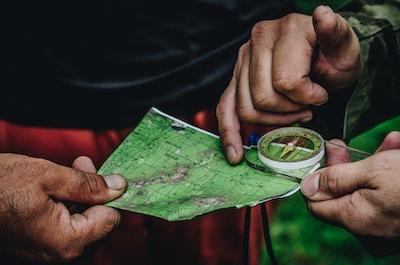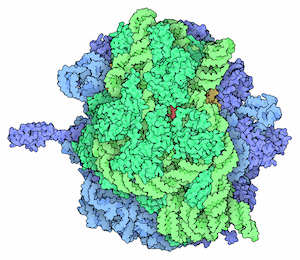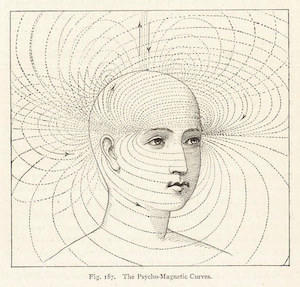
- Complexity Explorer /
- 16 Apr 2019
- Origins of Life Evolution Ecology Mathematics
Introducing "The Frontiers Course"
 In launching the Origins of Life course, we are debuting a new type of Complexity Explorer course: The Frontiers Course. A Frontiers Course gives students a tour of a currently emerging interdisciplinary research area, such as the Origins of Life. An understanding of the origin(s) of life will involve knowledge from the established disciplines of chemistry, geology, astrobiology, and biology, and more abstract insights from mathematics, physics, and computer science. However, there is not yet agreement on how these disciplines come together to offer new insights and move the research area forward.
In launching the Origins of Life course, we are debuting a new type of Complexity Explorer course: The Frontiers Course. A Frontiers Course gives students a tour of a currently emerging interdisciplinary research area, such as the Origins of Life. An understanding of the origin(s) of life will involve knowledge from the established disciplines of chemistry, geology, astrobiology, and biology, and more abstract insights from mathematics, physics, and computer science. However, there is not yet agreement on how these disciplines come together to offer new insights and move the research area forward. Working in new interdisciplinary areas and searching for emerging synergies and synthesis is a hallmark of Santa Fe Institute science. A Frontiers Course gives students a chance to learn about a new area of SFI-style science as it is coming together.
The structure of a Frontiers Course will be different from a Foundational Course, such as Fractals and Scaling. While there is much ongoing research in Fractals and Scaling, it is an established, multi-disciplinary area of study. There is agreement on key concepts, definitions, and methods.
In a Frontiers Course many different experts weigh in on their research and how they think about exploring open questions in this emerging area of research. The course will be guided by one or two lead instructors but will incorporate multiple voices and ideas that may at times contradict one another. A Frontiers Course explores terrain that is not yet fixed and may feel a little unsettled, speculative, and open-ended. This is by design. (Spoiler alert: We're not yet sure how life started!)
The goals of a Frontiers Course are to share the excitement and uncertainty of a new scientific area, inspire curiosity, and possibly draw new people into the research community who can help this emerging area take shape. Everyone is welcome to join us in our first Frontiers Course. Enrollment and all course materials are free.
 Guest Lecturers for Origins of Life
Guest Lecturers for Origins of LifeWe have an amazing cast of lecturers who are contributing to the Origins of Life course in addition to the lead instructors Chris Kempes and Sara Maurer - helping to provide a comprehensive survey of disciplines and ideas in this brand new Frontiers Course.
Enrollment will open in May!
David Krakauer - Santa Fe Institute President lectures on "The Multiple Origins of Life"
David Baum - Professor of Botany at the University of Wisconsin-Madison lectures on "The Meaning of Life", "Evolutionary Theory", "Life- Easy or Hard", and "Origins of Eukaryotes"
Zach Adam - Associate Staff Scientist, University of Arizona lectures on "Chemical Complexity" and "Geological Conditions, Change, and Chaos"
Michael Lachmann - Faculty, Santa Fe Institute lectures on "Quasispecies Selection Theory" and "Macroscopic Theories of Biology"
Nicolle Zellner - Professor, Albion College lectures on "Early Earth Bombardment History"
Chris Butch - Research Fellow, Earth Life Science Institute lectures on "Chemistry and the Origins of Life", "Why Water, Why Carbon?" and "Kinetic vs Thermodynamic Assembly Constraints "
Nathaniel Virgo - Specially Appointed Assistant Professor, Earth Life Science Institute lectures on "Polymer and Heterogeneous Networks and Autocatalysis"
Kate Adamala - Assistant Professor, University of Minnesota lectures on "Early Metabolisms" and "What did LUCA look like?"
Shawn McGlynn - Associate Professor, Earth Life Science Institute lectures on "Energy Harvesting Across Membranes"
Mayuko Nakagawa - Specially Appointed Assistant Professor, Earth Life Science Institute lectures on " Biogeochemistry and the Geologic Record"

Tony Jia - Research Scientist, Earth Life Science Institute lectures on "The RNA World"
Wim Hordijk - Independent Scientist lectures on "Autocatalytic Sets: A Cooperative Origin of Life"
Michael Travisano - Professor, University of Minnesota lectures on "Evolutionary Theory" and "Niche Construction"
Betul Kacar - Assistant Professor, University of Arizona lectures on "Phylogenetics"
Sara Walker - Professor, Arizona State University lectures on " Artificial Life Theory", "The Stranger Theories of What Life Could Be", Origins of Life and Astrobiology" and "Abstract and General Models for Life"
Andy Rominger - Postdoctoral Scholar, Santa Fe Institute lectures on "Phylogenetics" and "Evolutionary Theory"
Elizabeth Tasker - Associate Professor, Institute of Space and Astronautical Sciences lectures on "Exoplanets and the Habitable Zone"
Yuka Fujii - Specially Appointed Associate Professor, Earth Life Science Institute lectures on "Exoplanet Atmospheric Characterization"
If you are looking forward to this new course and want to support it and more like it please consider donating if you can! We are currently 16% of our way to our annual goal, thank you all for your support so far!
Exploring the Tree of Life with James Rosindell
James is a research fellow and lecturer in Biodiversity Theory and Science communication at Imperial College, London. James is the co-creator of OneZoom – An interactive map of the evolutionary relationships between over two million species of life on our planet.
 Linden: Briefly what excites you about your research?
Linden: Briefly what excites you about your research?James: What excites me is that it involves computers and writing code and quite heavy technical challenges, but it also involves the natural world and nature. Those two things seem like they are very, different and disconnected, but actually a lot can be achieved by bringing computing to bear against problems in nature.
Linden: Why is your area of scientific discovery relevant for an ordinary citizen of the world?
James: I think that all ordinary citizens of the world have some connection with non-human, living things. In order to make sure that we have those things in the future, we need to understand how they work, we need to be able to make projections about why they are the way they are and how this might change as humans progress towards ever more powerful influences over the world.
In terms of the OneZoom project, which is a side project for me - I think it is absolutely fundamental to know where all of this life came from. Its the nature in your garden, the food on your plate the plant that you have on your windowsill and the pet you enjoy spending time with.
How does it connect with the other living things on the planet?
Where did it come from?
I think these are pretty fundamental things- and so there are many hooks into the tree of life that interest the general public - and it is just the case of presenting them in the right way: remove the geekery and just give people the best and most interesting.
 Linden: So how did you come up with the idea of OneZoom?
Linden: So how did you come up with the idea of OneZoom?James: I have a frustration with science and scientific literature. I think that there is a huge amount of unnecessary information, we don't need to write these verbose papers where the same introduction gets repeated in every paper. My ideal transmission of knowledge between scientists would be a giant mind map of all of human knowledge that you can explore. If you think of something genuinely new, then you can just press a little ( + ) button and a new bubble appears to add a new idea.
So, how can you explore a mind map of all human knowledge? For me - as a person who has always been interested in fractals, ever since I was drawing fractals on a 286 computer - it seemed to me that fractals would be the best and most natural way to explore such a mind map of all human knowledge. You have something that is beautiful, that you can zoom around in a way that is familiar but actually everywhere you go there is an amazing piece of knowledge to be discovered.
So I had all this in the back of my mind the day that I went to Down House of Charles Darwin in 2011 and walked around Darwin’s thinking path. One of the friends I was with, Luke Harmon, made a very big deal out of the fact that we were walking around Darwin's thinking path and the amazing ideas that would result. I was skeptical about this, but literally a few hours later, on our way back from Darwin’s house, Luke was bemoaning how we are all building these big trees (phylogenies) and with no nice way to look at them. This was when I realized the fractal mind map idea could instead be used to visualize a phylogeny! This was the moment that OneZoom was first imagined. A few of years later we teamed up with Yan Wong, a professional science communicator and co-author of The Ancestor’s Tale with Richard Dawkins, to found OneZoom as a charitable incorporated organization (non-profit) in the UK. This was the final major step towards creating the OneZoom we see today. Yan and I still regularly work on the project on a day-to-day basis.
Linden: For you personally, what do think the coolest thing about OneZoom is?
James: I personally think the coolest thing is the overarching idea, the idea of combining fractals with the zooming user interface to display this kind of big data more generally.
But if I am allowed to have two things then the other thing would be just having all of life on earth in once place where you can explore it. But it is important to highlight that OneZoom is made possible by linking to, state of the art, bigger, and well-funded projects that we think are the leaders in giving information about the tree of life (Open Tree of Life), conservation (IUCN), species’ common names, and species’ images (Encyclopedia of Life). OneZoom is an attempt to become part of, and to help strengthen, a web of existing resources and to connect that to the general public in a novel and engaging way.
Linden: What do you hope the impact of OneZoom is?
James: The intention is for it to have a broad use, the original idea was for it to be a science outreach effort - for it to be like ‘the Google Earth of Biology’.
We would like more of what we have seen already! A lot more use in classrooms, a lot more general public using it to explore life and discover things that they did not realize existed. This includes people who are not necessarily convinced about evolution. By empowering the user to choose where they want to go and using the breadth of the scope of all of life, to hook in different kinds of people.
Another key part of what we do is spreading messages about conversation and that is why we are really pleased that we link to the International Union for Conservation of Nature (IUCN) Red List and we show this really prominent coloring about extinction risk too.
OneZoom is not finished - we are looking for help, we are looking for museums to put up new displays on touch tables. We are looking for people who are experts at programing to contribute. We are looking for people to sponsor the leaves to support OneZoom! We don't want to be a one-way thing - we really want to encourage people to join something bigger here!
A really great example of this is the One Tree One Planet Project - which is in collaboration with the digital artist Naziha Mestaoui and scientists Doug and Pam Soltis, Robert Guralnick and Matt Gitzendanner.

Finally, and critically, because we’re are a not for profit we have a sustainability plan – this is a key thing as well, we are not just publishing a paper with some code and hoping for the best, we’re creating something that we hope will continue to be maintained and updated for many years to come. Our plan to sustain OneZoom in the future involves allowing people to sponsor leaves on the tree of life in exchange for a donation to the OneZoom non-profit organization. These donations are what keep us going in the absence of more substantial research funding for this kind of project.
Linden: How does OneZoom relate to your area of research - do you see parallels or is it really just a side project?
James: At the core of my research is the connection between computing, data and technology to ecology, evolution, and conservation. OneZoom is an instance of where technology and computers have been brought to bear on a problem in ecology, evolution, and conservation.
In terms of my other research, as a person that analyzes trees and who makes models that produce phylogenetic trees, there is a connection here.
And then the third connection, probably the strongest one, is my interest in the EDGE of Existence Programme at Zoological Society of London which focuses conservation efforts on species that are evolutionarily distinct and globally endangered. I see it as a way of optimizing conservation actions to save as much of the tree of life as possible, based on recognition that some species connected by long branches to the rest of the tree of life and are particularly evolutionary distinct, to use the terminology. It would particularly sad to lose a species that's really distinct and unique from the tree of life. There is a whole field of research around this, which interests me a lot. I think it fits very well with OneZoom and it is an area I want to work in more on in terms of my future research.
Linden: What are your thoughts on how OneZoom can help us understand the origin of life?

James: The distinction between the two aspects of the origin of life is important. The first aspect is where did the initial spark come from? That is how did the organic self-replicating stuff come from just chemicals floating around the in ocean; this is not really an evolutionary question. The second aspect is how did the myriad of life that we know today follow from this first life? This is an evolutionary question, indeed it is evolution, and this is exactly what OneZoom has been created to help us understand: OneZoom characterizes the full map of what happens in the diversification process.
Linden: At SFI we like to frame life in terms of information - is life just information? And where do we draw the line for life then?
I really buy this idea of life as a kind of information, though of course life is not just information. Related to this, I wonder if documenting the tree of life in the way that OneZoom and its data sources do is itself a form of conservation, as far as the information part is concerned.
 Consider an analogy, if an art gallery burns down, it would be a lot more tragic if none of its art had been digitized as compared to a case where everything has been digitized in high resolution so people can continue to study and enjoy (to some extent) those things. I think that there is a kind of digital conservation going on where we document things so they are not entirely lost. This is by no means a replacement for proper conservation of ecosystems and species, which is by far the most important. Actually, taking digital records can help with this too because it helps communicate to people what we have to lose at the global scale, if, for example, we fail to act on the pressing global conservation issues.
Consider an analogy, if an art gallery burns down, it would be a lot more tragic if none of its art had been digitized as compared to a case where everything has been digitized in high resolution so people can continue to study and enjoy (to some extent) those things. I think that there is a kind of digital conservation going on where we document things so they are not entirely lost. This is by no means a replacement for proper conservation of ecosystems and species, which is by far the most important. Actually, taking digital records can help with this too because it helps communicate to people what we have to lose at the global scale, if, for example, we fail to act on the pressing global conservation issues.The other thing I have mentioned that supports the ‘life as information idea’ is conservation prioritization based on saving as much as possible of the tree of life, in terms of branch lengths (not just numbers of species). One view of why you might wish to conserve a species with a long branch connecting it to the tree of life, an evolutionary distinct species, is that it contains more unique information than does another species connected to the rest of the tree by much shorter branches.
Linden: What's your favorite species on the tree?
I have no single answer, there is just so many that I love - there is so much there! That’s exactly what OneZoom illustrates - just put in a funny word and search for it and you will find the Nervous shark, that will be your temporary favorite because it is so amusingly named. Having said this, I have a soft spot for octopuses, pitcher plants and frogs on the tree of life!
Linden: Thanks James!
Thanks so much Linden for taking this interview, it’s been great to do something for the Complexity Explorer. Don’t forget to take a look at the OneZoom website!
A Productive 2019 in Subtitles!
In the first few months of 2019 both Diego Diaz Cordova and Hazm Talab broke the 600 minute mark, putting in some
 serious time on Introduction to Dynamical Systems and Chaos, Fractals and Scaling, and Agent-Based Modeling. We will be offering Agent-Based Modeling starting July 1st - enrollment will open in May, so keep your eye out!
serious time on Introduction to Dynamical Systems and Chaos, Fractals and Scaling, and Agent-Based Modeling. We will be offering Agent-Based Modeling starting July 1st - enrollment will open in May, so keep your eye out! We have two new t-shirt winners this month:
- Francisco Baeta breaking the 120 minute mark subtitling in Portuguese for our Fractals and Scaling course.
- Matias Agelvis breaking the 120 minute mark subtitling in Spanish for the Complexicon videos, among others.
I will be contacting you both for your t-shirt sizes - congratulations and thank you!
We also saw a new, super productive member team join - Alexander Krotov subtitling 99 minutes our Introduction to Renormalization tutorial in English - well on your way to a t-shirt!
If you want to join our team - speaking 64 different languages - more information can be found here.
